Soham De
Question the Questions: Auditing Representation in Online Deliberative Processes
Nov 06, 2025Abstract:A central feature of many deliberative processes, such as citizens' assemblies and deliberative polls, is the opportunity for participants to engage directly with experts. While participants are typically invited to propose questions for expert panels, only a limited number can be selected due to time constraints. This raises the challenge of how to choose a small set of questions that best represent the interests of all participants. We introduce an auditing framework for measuring the level of representation provided by a slate of questions, based on the social choice concept known as justified representation (JR). We present the first algorithms for auditing JR in the general utility setting, with our most efficient algorithm achieving a runtime of $O(mn\log n)$, where $n$ is the number of participants and $m$ is the number of proposed questions. We apply our auditing methods to historical deliberations, comparing the representativeness of (a) the actual questions posed to the expert panel (chosen by a moderator), (b) participants' questions chosen via integer linear programming, (c) summary questions generated by large language models (LLMs). Our results highlight both the promise and current limitations of LLMs in supporting deliberative processes. By integrating our methods into an online deliberation platform that has been used for over hundreds of deliberations across more than 50 countries, we make it easy for practitioners to audit and improve representation in future deliberations.
Optimizers Qualitatively Alter Solutions And We Should Leverage This
Jul 16, 2025Abstract:Due to the nonlinear nature of Deep Neural Networks (DNNs), one can not guarantee convergence to a unique global minimum of the loss when using optimizers relying only on local information, such as SGD. Indeed, this was a primary source of skepticism regarding the feasibility of DNNs in the early days of the field. The past decades of progress in deep learning have revealed this skepticism to be misplaced, and a large body of empirical evidence shows that sufficiently large DNNs following standard training protocols exhibit well-behaved optimization dynamics that converge to performant solutions. This success has biased the community to use convex optimization as a mental model for learning, leading to a focus on training efficiency, either in terms of required iteration, FLOPs or wall-clock time, when improving optimizers. We argue that, while this perspective has proven extremely fruitful, another perspective specific to DNNs has received considerably less attention: the optimizer not only influences the rate of convergence, but also the qualitative properties of the learned solutions. Restated, the optimizer can and will encode inductive biases and change the effective expressivity of a given class of models. Furthermore, we believe the optimizer can be an effective way of encoding desiderata in the learning process. We contend that the community should aim at understanding the biases of already existing methods, as well as aim to build new optimizers with the explicit intent of inducing certain properties of the solution, rather than solely judging them based on their convergence rates. We hope our arguments will inspire research to improve our understanding of how the learning process can impact the type of solution we converge to, and lead to a greater recognition of optimizers design as a critical lever that complements the roles of architecture and data in shaping model outcomes.
From job titles to jawlines: Using context voids to study generative AI systems
Apr 16, 2025Abstract:In this paper, we introduce a speculative design methodology for studying the behavior of generative AI systems, framing design as a mode of inquiry. We propose bridging seemingly unrelated domains to generate intentional context voids, using these tasks as probes to elicit AI model behavior. We demonstrate this through a case study: probing the ChatGPT system (GPT-4 and DALL-E) to generate headshots from professional Curricula Vitae (CVs). In contrast to traditional ways, our approach assesses system behavior under conditions of radical uncertainty -- when forced to invent entire swaths of missing context -- revealing subtle stereotypes and value-laden assumptions. We qualitatively analyze how the system interprets identity and competence markers from CVs, translating them into visual portraits despite the missing context (i.e. physical descriptors). We show that within this context void, the AI system generates biased representations, potentially relying on stereotypical associations or blatant hallucinations.
How do language models learn facts? Dynamics, curricula and hallucinations
Mar 27, 2025Abstract:Large language models accumulate vast knowledge during pre-training, yet the dynamics governing this acquisition remain poorly understood. This work investigates the learning dynamics of language models on a synthetic factual recall task, uncovering three key findings: First, language models learn in three phases, exhibiting a performance plateau before acquiring precise factual knowledge. Mechanistically, this plateau coincides with the formation of attention-based circuits that support recall. Second, the training data distribution significantly impacts learning dynamics, as imbalanced distributions lead to shorter plateaus. Finally, hallucinations emerge simultaneously with knowledge, and integrating new knowledge into the model through fine-tuning is challenging, as it quickly corrupts its existing parametric memories. Our results emphasize the importance of data distribution in knowledge acquisition and suggest novel data scheduling strategies to accelerate neural network training.
RecurrentGemma: Moving Past Transformers for Efficient Open Language Models
Apr 11, 2024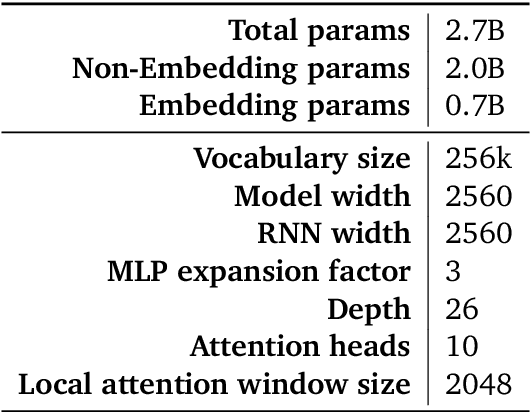
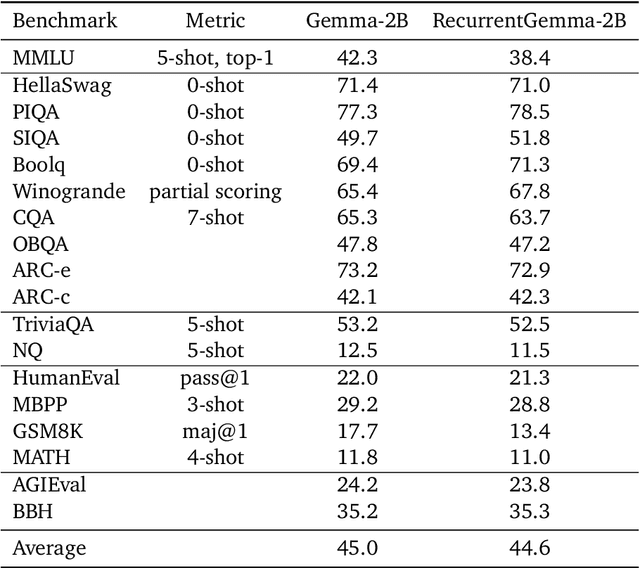
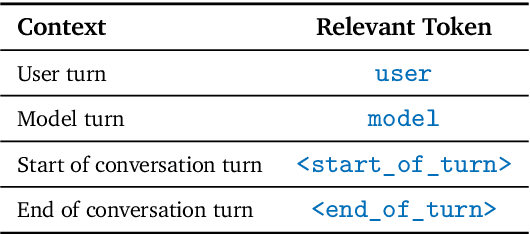
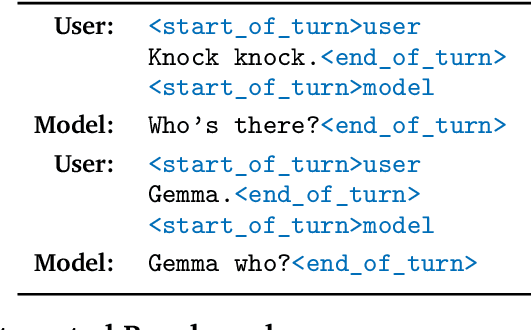
Abstract:We introduce RecurrentGemma, an open language model which uses Google's novel Griffin architecture. Griffin combines linear recurrences with local attention to achieve excellent performance on language. It has a fixed-sized state, which reduces memory use and enables efficient inference on long sequences. We provide a pre-trained model with 2B non-embedding parameters, and an instruction tuned variant. Both models achieve comparable performance to Gemma-2B despite being trained on fewer tokens.
Gemma: Open Models Based on Gemini Research and Technology
Mar 13, 2024



Abstract:This work introduces Gemma, a family of lightweight, state-of-the art open models built from the research and technology used to create Gemini models. Gemma models demonstrate strong performance across academic benchmarks for language understanding, reasoning, and safety. We release two sizes of models (2 billion and 7 billion parameters), and provide both pretrained and fine-tuned checkpoints. Gemma outperforms similarly sized open models on 11 out of 18 text-based tasks, and we present comprehensive evaluations of safety and responsibility aspects of the models, alongside a detailed description of model development. We believe the responsible release of LLMs is critical for improving the safety of frontier models, and for enabling the next wave of LLM innovations.
Griffin: Mixing Gated Linear Recurrences with Local Attention for Efficient Language Models
Feb 29, 2024Abstract:Recurrent neural networks (RNNs) have fast inference and scale efficiently on long sequences, but they are difficult to train and hard to scale. We propose Hawk, an RNN with gated linear recurrences, and Griffin, a hybrid model that mixes gated linear recurrences with local attention. Hawk exceeds the reported performance of Mamba on downstream tasks, while Griffin matches the performance of Llama-2 despite being trained on over 6 times fewer tokens. We also show that Griffin can extrapolate on sequences significantly longer than those seen during training. Our models match the hardware efficiency of Transformers during training, and during inference they have lower latency and significantly higher throughput. We scale Griffin up to 14B parameters, and explain how to shard our models for efficient distributed training.
ConvNets Match Vision Transformers at Scale
Oct 25, 2023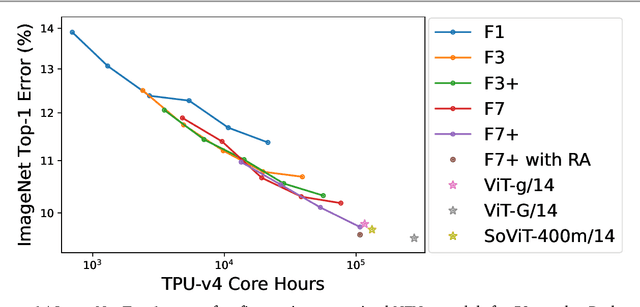
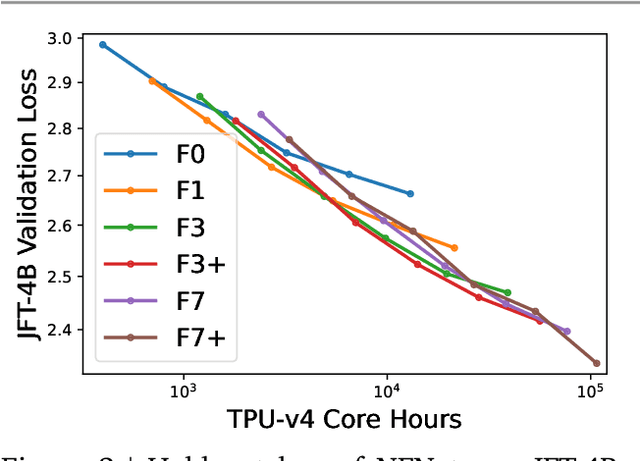
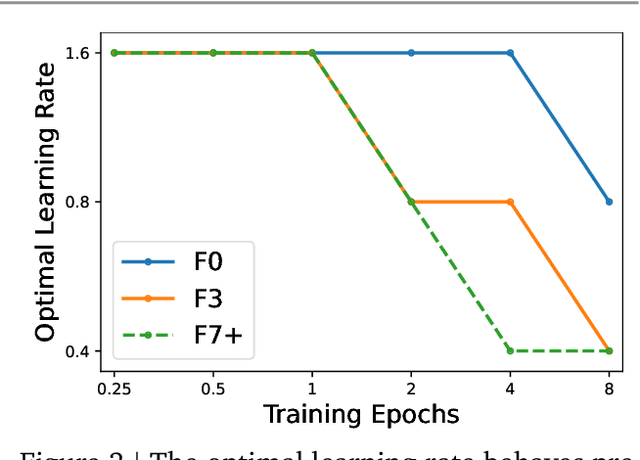
Abstract:Many researchers believe that ConvNets perform well on small or moderately sized datasets, but are not competitive with Vision Transformers when given access to datasets on the web-scale. We challenge this belief by evaluating a performant ConvNet architecture pre-trained on JFT-4B, a large labelled dataset of images often used for training foundation models. We consider pre-training compute budgets between 0.4k and 110k TPU-v4 core compute hours, and train a series of networks of increasing depth and width from the NFNet model family. We observe a log-log scaling law between held out loss and compute budget. After fine-tuning on ImageNet, NFNets match the reported performance of Vision Transformers with comparable compute budgets. Our strongest fine-tuned model achieves a Top-1 accuracy of 90.4%.
Unlocking Accuracy and Fairness in Differentially Private Image Classification
Aug 21, 2023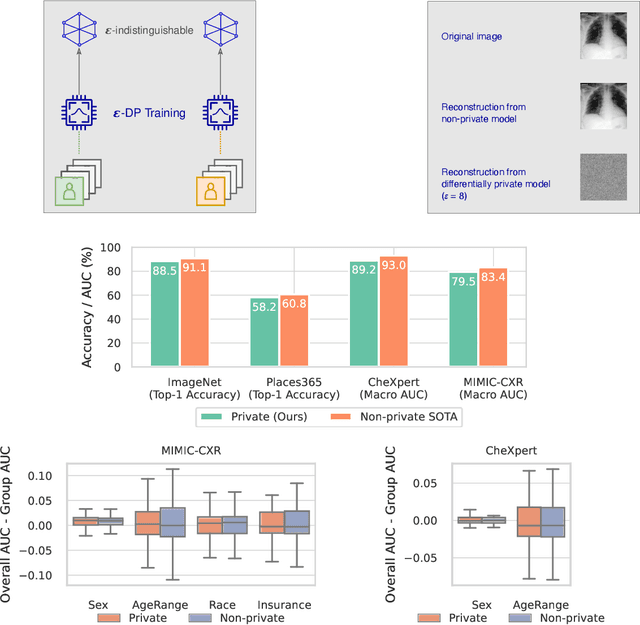

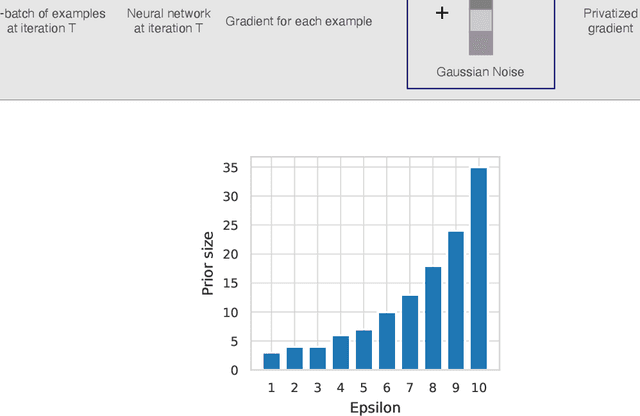

Abstract:Privacy-preserving machine learning aims to train models on private data without leaking sensitive information. Differential privacy (DP) is considered the gold standard framework for privacy-preserving training, as it provides formal privacy guarantees. However, compared to their non-private counterparts, models trained with DP often have significantly reduced accuracy. Private classifiers are also believed to exhibit larger performance disparities across subpopulations, raising fairness concerns. The poor performance of classifiers trained with DP has prevented the widespread adoption of privacy preserving machine learning in industry. Here we show that pre-trained foundation models fine-tuned with DP can achieve similar accuracy to non-private classifiers, even in the presence of significant distribution shifts between pre-training data and downstream tasks. We achieve private accuracies within a few percent of the non-private state of the art across four datasets, including two medical imaging benchmarks. Furthermore, our private medical classifiers do not exhibit larger performance disparities across demographic groups than non-private models. This milestone to make DP training a practical and reliable technology has the potential to widely enable machine learning practitioners to train safely on sensitive datasets while protecting individuals' privacy.
On the Universality of Linear Recurrences Followed by Nonlinear Projections
Jul 21, 2023



Abstract:In this note (work in progress towards a full-length paper) we show that a family of sequence models based on recurrent linear layers~(including S4, S5, and the LRU) interleaved with position-wise multi-layer perceptrons~(MLPs) can approximate arbitrarily well any sufficiently regular non-linear sequence-to-sequence map. The main idea behind our result is to see recurrent layers as compression algorithms that can faithfully store information about the input sequence into an inner state, before it is processed by the highly expressive MLP.
 Add to Chrome
Add to Chrome Add to Firefox
Add to Firefox Add to Edge
Add to Edge